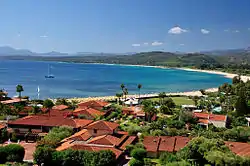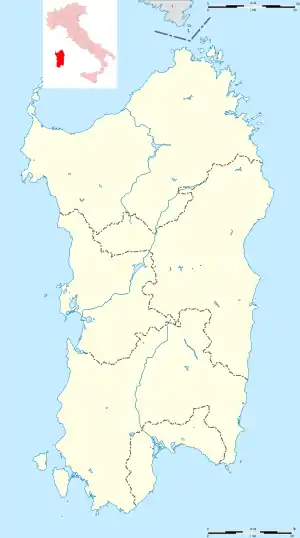Arbatax
Arbatax (Italian pronunciation: [arbaˈtaks];[1] Sardinian: Arbatassa) is the largest hamlet (frazione) of Tortolì, Sardinia, in Italy. With almost 5,000 inhabitants, it is also the third largest town in its province (Nuoro) by population, after Lanusei municipality (5,700) and Tortolì proper [2] (5,300).
Arbatax
| |
|---|---|
Frazione of Tortolì | |
 | |
 Arbatax Location in Sardinia | |
| Coordinates: 39.927°N 9.702°E | |
| Country | Italy |
| Region | Sardinia |
| County | Municipality of Tortolì |
| City | Tortolì |
| Population | |
| • Total | 5,000 |
History
The origin of the name Arbatax is uncertain; according to tradition it derived from the Arabic for "14th Tower" and refers, probably, to the nearby watchtower built by the Spaniards to protect the territory from the incursion of Arab pirates.[3]
The founders of Arbatax were Campanian fishermen from the island of Ponza, located in Lazio, close to the coast of the Italian Peninsula.
The location assumed importance in the 1960s after the construction of the main Sardinian paper mill.
Geography
The town is situated by the Tyrrhenian Sea, 5 km east of Tortolì.
Transport
The port is used by ferries to and from Civitavecchia and Olbia and is also monopolized by the marine construction company Intermare, which builds gas rigs and vessels. The marina is one of the cheapest in Sardinia.
The town is connected to Lanusei and Cagliari by a narrow gauge railway, today used for touristic purposes, owned by Ferrovie della Sardegna.
The closest airport is the Tortolì Airport, about 4 km from the town.
Economy
Today, the economy is focused on tourism and industry. Arbatax is home to a factory dedicated to the building of oil platforms, controlled by the Italian oil and gas industry contractor Saipem. Mussels are farmed in the nearby lagoon and fresh fish are on sale from the fishing cooperative. The red rocks are a tourist attraction.
Gallery
.jpg.webp)
Port 
Spanish tower 
Beach of Rocce Rosse
References
- Bruno Migliorini (ed.). "Turandot". Dizionario italiano multimediale e multilingue d'ortografia e di pronunzia (in Italian). Retrieved 8 August 2019.
- Population without hamlets
- "Sulla presenza araba in Sardegna e sulle sue conseguenze linguistiche, si vedano però le considerazioni di V. Brugnatelli, "Un nuovo arabismo sardo". Studi Mediolatini e Volgari 28 (. 1981. Missing or empty
|url=(help)
External links
| Wikimedia Commons has media related to Arbatax. |
- Tortolì-Arbatax Airport (IT)
- Comune of Tortolì (IT)
- Arbatax on marenostrum.it (IT)
- Arbatax on Sardegna.net (IT)